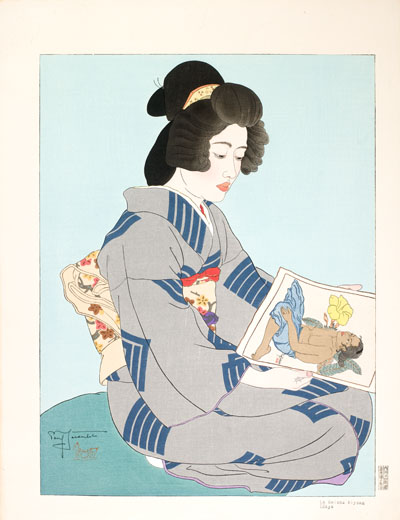The Jacoulet family moved to Tokyo in 1899 when Paul Jacoulet was just three years old. He completed his primary and secondary education in Tokyo as the only Westerner in his class, and was immersed in Japanese culture for the duration of his life. Jacoulet’s artistic inclinations intensified in the 1920s as he continued the serious study of oil painting and ukiyo-e painting. He also played the shamisen, a three-stringed musical instrument, and practiced gidayu, the chanted and sung texts of the traditional puppet theatre. During this time, Jacoulet also studied thousands of Japanese woodblock prints and was powerfully drawn to the work of the Edo period artist Kitagawa Utamaro (1753-1806).
Following in the collaborative tradition of ukiyo-e printmaking, Jacoulet worked with Japanese artists to create a distinct body of woodblock prints between 1934 and 1960. He collaborated with distinguished carvers and printers such as Yamagishi Kazue (1883-1966), Maeda Kentaro (c. 1891-1987), Honda Tetsunosuke (active 1934-1960), and Fujii Shūnosuke (active 1940-1950), among others. Of this artistic collaboration, Jacoulet has said "The woodcut colorprint is like music. Without harmony among painter, engraver and printer, it is impossible to produce a fine picture."
|
La Geisha Kiyoka. Tokyo (The Geisha Kiyoka. Tokyo)
1935 Color woodcut print Page size: 18 3/4 x 14 1/4 in. (47.6 x 36.2 cm) Image size: 11 3/4 x 15 1/2 in. (29.8 x 39.4 cm) Gift of Eugene Finkin in memory of Dorothy Finkin 2012.9.13 © 2012 Artists Rights Society (ARS), New York / ADAGP, Paris
Jacoulet often credited the master printmaker and painter Kitagawa Utamaro (1753-1806) as a formative influence in terms of compositional style and mastery of capturing human emotion. As demonstrated by this group of woodcuts, Jacoulet also shared Utamaro’s interest in bijinga, or pictures of beautiful women. This print depicts a friend of the artist as she admires Jacoulet’s first print, Jeune Fille de Saipan. |
Joruri Singer
1936 Color woodcut print 10 7/8 x 16 7/8 in. (27.6 x 42.9 cm) Gift of Eugene Finkin in memory of Dorothy Finkin 2012.9.9 © 2012 Artists Rights Society (ARS), New York / ADAGP, Paris
Joruri is a type of music that accompanies bunraku, the traditional Japanese puppet theater, and incorporates vocals and a three-stringed instrument known as the shamisen. Jacoulet’s model for this print was a well-known joruri performer, Tōchō, who taught him many of his favorite traditional songs. The simple, flat outlines of the composition stand in contrast to the beautiful texture and patterning of the robe which was achieved with the use of embossing blocks, or gauffrage. Although the drawing study for this print was one of the artist’s favorites, less than 100 impressions of it were printed and only a few examples survive today. |





